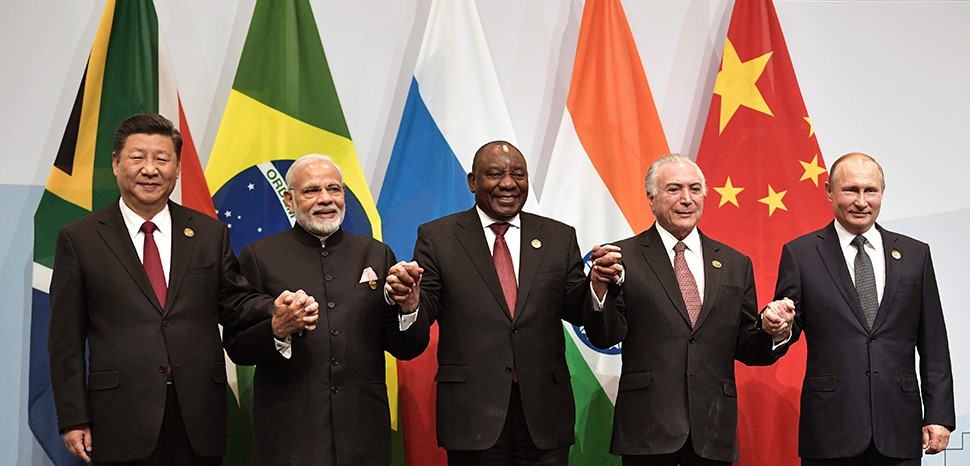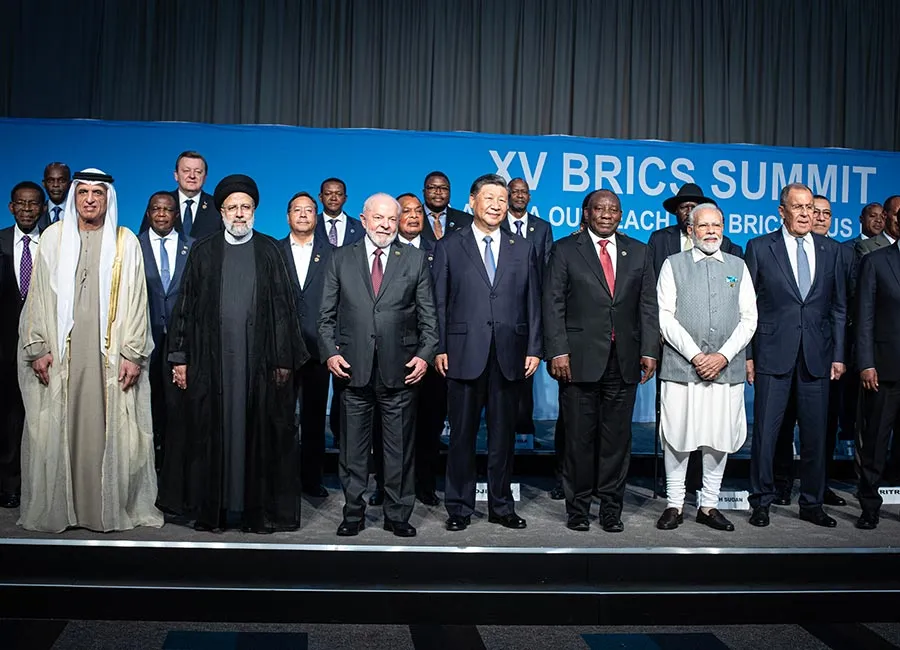BRICS, an acronym encompassing Brazil, Russia, India, China, and South Africa, constitutes a remarkable geopolitical and economic alliance. The journey of BRICS commenced with the term “BRIC,” initially introduced by Jim O’Neill of Goldman Sachs in 2001. This term spotlighted the burgeoning economic might of these four nations. The alliance expanded further when South Africa joined in 2010, giving birth to BRICS.
Initiated by Russia in 2009, BRICS has played a pivotal role in challenging Western dominance and reshaping the global economic landscape. Unlike conventional international organisations, BRICS operates informally, placing emphasis on economic cooperation, trade, and development.
With substantial collective populations and economies, BRICS nations yield considerable influence globally. This alliance presents an alternative perspective, advocating for reforms to ensure equitable representation in international institutions.
Within the BRICS framework, notable initiatives like the New Development Bank (NDB) and the Contingent Reserve Arrangement (CRA) have been established. These endeavours aim to counterbalance the influence of the G7 nations and provide a robust platform for economic collaboration.
While BRICS expands its membership, it grapples with challenges such as coordinating diverse interests and maintaining a cohesive stance. With over 40 countries expressing interest in joining, the expansion process is meticulously approached. Countries like Brazil and India proceed cautiously, factoring in concerns about influence and cohesion.

BRICS symbolises a growing sentiment of dissatisfaction with the prevailing Western-led global order. It strives to foster unity among emerging markets, promoting economic growth, social development, and technological cooperation.
In recent years, BRICS has evolved into a pivotal player in international affairs. Its emphasis on economic cooperation and its unique approach to global governance have garnered widespread attention and support. As the alliance adapts and grows, its influence on reshaping the global economic and political landscape remains a point of significant interest.
Interestingly, during the 15th BRICS summit in Johannesburg, Brazil’s President Luiz Inacio Lula da Silva proposed the creation of a common currency for trade and investment among BRICS nations. This proposition aimed to reduce their vulnerability to dollar exchange rate fluctuations. While challenges in implementation abound, such an initiative underscores BRICS’s innovative approach to global economic dynamics and its commitment to fostering collaboration.
The BRICS group of leading emerging economies has taken a significant stride in broadening its influence, as it has announced the invitation of six additional nations to join its ranks as new members.
Argentina, Egypt, Ethiopia, Iran, Saudi Arabia, and the United Arab Emirates have all received invitations to become full members starting from January 1 of the upcoming year.
Originally established in 2009 with Brazil, Russia, India, and China as founding members, the BRICS group expanded to include South Africa in 2010.
This expansion seeks to strengthen a united front of developing nations that can better advocate for the interests of the Global South on the international stage.
Prior to the commencement of their annual summit in South Africa this week, over 40 countries had expressed their desire to join BRICS, and out of these, 23 submitted formal applications for membership.
“We acknowledge the significant interest displayed by Global South countries in joining BRICS,” the group stated in the Johannesburg II declaration, which was adopted on the final day of the summit on Thursday.
The six new invitees were selected after “BRICS countries reached a consensus on the guiding principles, standards, criteria, and procedures of the BRICS expansion process,” as detailed in the declaration. However, specific criteria were not elaborated upon.

“These six invited countries share little in common apart from their status as important nations within their respective regions,” observed Danny Bradlow, a professor at the University of Pretoria.
With the inclusion of Saudi Arabia, Iran, the UAE, and Egypt, the grouping could be seen as having a Middle East focus, suggesting geopolitical and geo-economic implications. This development might prompt BRICS members to reconsider their Middle East strategies and potentially lead China and India to revise their existing policies.
A recent instance where China brokered reconciliation between Saudi Arabia and Iran highlights the shifting dynamics. Similarly, India’s agreement with the UAE to trade in their own currencies rather than the US dollar signifies an evolving economic landscape.
Notably, the expansion seems to prioritise countries with significant energy-related connections, prompting some observers to humorously question if it should be dubbed “BRICS plus OPEC?”
The consideration of energy pricing and strategies to minimise vulnerability in terms of oil costs might have influenced the selection process, particularly given that, besides Russia, the core BRICS countries are not major energy producers.
Challenging the dominance of unilateral sanctions and the US dollar in global trade has been a stance championed by BRICS.
The expansion paves the way for fresh trade possibilities, enhancing trade between BRICS nations using their local currencies. This shift could contribute to reducing dependence on the US dollar.
Iran appears poised to benefit the most from this approach, as its inclusion signifies its reduced isolation and potential economic gains through increased bilateral trade. Argentina’s inclusion was supported by Brazil, China, and India.
Ethiopia’s rapidly growing economy and its hosting of the African Union headquarters make its inclusion logical. Egypt, Saudi Arabia, and the UAE share similarities with India and South Africa in terms of their diplomatic alignments.
Saudi Arabia’s positioning suggests a broader range of alliances beyond the United States. This diversification might enable the nation to leverage multiple options, such as its rapprochement with Iran brokered by China.
While the implications of an expanded BRICS remain uncertain, the group’s larger representation in terms of population and economy could bolster its potential influence on global governance arrangements.
Nonetheless, it remains to be seen whether the expanded group will succeed in driving more effective reforms and better serving the interests of the Global South. The inclusion of Iran could send a powerful message to the G7 and the Global North, indicating the group’s resolve to manage its internal challenges without external interference.
As this expansion takes shape, it is unclear how much impact it will have on the existing global order, but it does provide a platform for enhanced cooperation among these nations.
sources
- https://www.aljazeera.com/news/2023/8/24/analysis-wall-of-brics-the-significance-of-adding-six-new-members
- https://www.reuters.com/markets/currencies/what-is-brics-currency-could-one-be-adopted-2023-08-23/
- https://economictimes.indiatimes.com/definition/brics
- https://www.investopedia.com/terms/b/brics.asp
- http://www.indiandefencereview.com/news/brics-and-de-dollarization/




